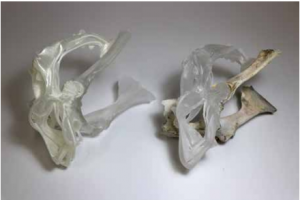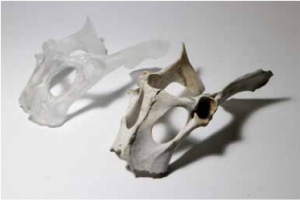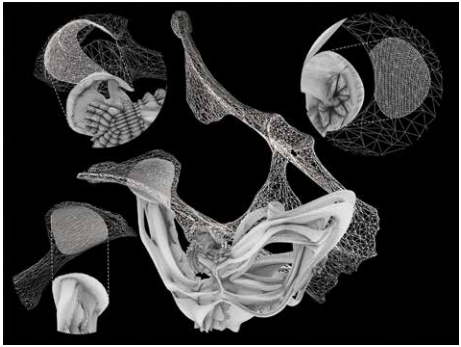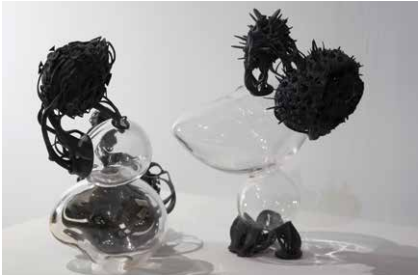Tobias Klein is an artist and architect who, in 2017, spent time as an Artist in Residence at the Pilchuck Glass School. During his time at the school, he developed two works of art that explored the relationship between three different methods of fabrication: glassblowing, glass casting and 3D printing.
“In order to explore this relationship I planned two lines of inquiry into glassblowing and glass casting,” Klein says. “Additionally, I set up a dialogue between the materials and processes used in the resulting objects and examined the advantages and restrictions occurring in the translation between digital and traditional methods. Therefore, the artworks would retain qualities of the different toolpaths and workflows. The traces of each process would allow me to identify synergies and new narratives between them.”
For the first work, titled Augmented Fauna, Klein began with the pelvic bone of a deer. First he employed a traditional method of casting to create a glass cast of the bone. He then 3D scanned the cast and created a 3D model which he digitally added on to, creating a digital “prosthesis.”
“I used the bridging software tool to sculpt a rough connecting volume between the areas and a series of interconnected tendril-like substructures, attached to the emerging mesh,” he explains. “Lastly, I applied topological surface mesh modifications (push, pull, extrude, subdivision modeling, etc.) to the resulting mesh, imitating the natural growth of the bone substrate.”
 Klein then 3D printed the prosthesis, using PLA and a Flashforge 3D printer, and grafted it onto the glass cast to create a new geometry. He then used another 3D print of the prosthesis to create a cast using the 3D printed substrate instead of wax. He 3D printed the substrate with a honeycomb structure and a dense, precisely articulated outer shell, which allowed it to burn out more cleanly and create a better surface finish in the resulting glass cast. Klein then grafted the new glass cast onto the original deer bone, ending up with two geometrically identical sculptures that had been created using multiple technologies.
Klein then 3D printed the prosthesis, using PLA and a Flashforge 3D printer, and grafted it onto the glass cast to create a new geometry. He then used another 3D print of the prosthesis to create a cast using the 3D printed substrate instead of wax. He 3D printed the substrate with a honeycomb structure and a dense, precisely articulated outer shell, which allowed it to burn out more cleanly and create a better surface finish in the resulting glass cast. Klein then grafted the new glass cast onto the original deer bone, ending up with two geometrically identical sculptures that had been created using multiple technologies.
The second work is called Glass Mutations, which was formed using glassblowing and 3D printing and is based on cell mitosis. Klein employed the help of two glassblowers to create cell-like objects, which were then incorporated into larger installations using 3D printing.
“Deforming the glass surface by pulling it locally, we created geometrical anomalies that became attachment points and, ultimately, interfaces between the glass, 3D scan and printed object,” he explains. “They enable Cartesian recognition in the 3D scan and, later in the assembly of print and glass, mechanically hold the 3D-printed elements in tension…
“Glass Mutations is not a work centered around the geometric complexity of glass and the imitation of the formal impossibilities of 3D printing. Glass Mutations is an amalgamate of glass volumes held in a larger organism-like construct through 3D-printed substrates. Differently from the augmentation experiment—Augmented Fauna—the new objects are not static and conclusive in themselves, but rather suspended in an arrangement that can only exist in a 3D-scanned state of sublimation. This work consists of the physical separation of the cellular glass volumes from one another and the 3D-printed form interacting with these single objects to form an ecosystem between the glass volumes. The elements are held together by digitally modeled, tendril-like structures, analogous to biological cell growth when forming multi-cellular higher-order organisms.”
Glass Mutations is a surreal, striking piece of work that resembles odd creatures or strange plants. It’s much more fantastical-looking than Augmented Fauna, which is more scientific in its approach. While glass can be directly 3D printed, Klein avoids that approach and instead explores the interplay between 3D printing and more traditional methods of glass crafting – and the results are quite stunning. You can read more about Klein’s work in his paper “Augmented Fauna and Glass Mutations: A Dialogue Between Material and Technique in Glassblowing and 3D Printing.”
Discuss this and other 3D printing topics at 3DPrintBoard.com or share your thoughts below.
[Images: Tobias Klein]
Subscribe to Our Email Newsletter
Stay up-to-date on all the latest news from the 3D printing industry and receive information and offers from third party vendors.
You May Also Like
3D Printing News Briefs, April 13, 2024: Robotics, Orthotics, & Hypersonics
In 3D Printing News Briefs today, we’re focusing first on robotics, as Carnegie Mellon University’s new Robotics Innovation Center will house several community outreach programs, and Ugogo3D is now working...
Rail Giant Alstom Saves $15M with 3D Printing Automation Software 3D Spark
3D Spark has entered into a three-year deal with the rail giant Alstom. Alstom, a transport behemoth with annual revenues of $16 billion, specializes in the manufacture of trains, trams,...
Meltio Expands Global Reach with New Partnerships in the Americas and Europe
Spanish 3D printing manufacturer Meltio has expanded its sales network across the globe. With the addition of three new partners in the United States, Brazil, Argentina, and Italy, Meltio aims...
3D Printing Webinar and Event Roundup: April 7, 2024
Webinars and events in the 3D printing industry are picking back up this week! Sea-Air-Space is coming to Maryland, and SAE International is sponsoring a 3D Systems webinar about 3D...


































